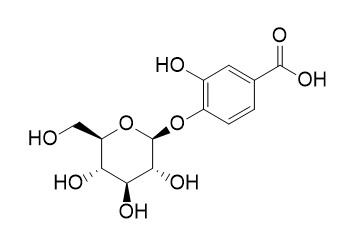Protocatechuic acid 4-O-beta-glucoside
Inquire / Order:
manager@chemfaces.com
Technical Inquiries:
service@chemfaces.com
Tel:
+86-27-84237783
Fax:
+86-27-84254680
Address:
1 Building, No. 83, CheCheng Rd., Wuhan Economic and Technological Development Zone, Wuhan, Hubei 430056, PRC
Providing storage is as stated on the product vial and the vial is kept tightly sealed, the product can be stored for up to
24 months(2-8C).
Wherever possible, you should prepare and use solutions on the same day. However, if you need to make up stock solutions in advance, we recommend that you store the solution as aliquots in tightly sealed vials at -20C. Generally, these will be useable for up to two weeks. Before use, and prior to opening the vial we recommend that you allow your product to equilibrate to room temperature for at least 1 hour.
Need more advice on solubility, usage and handling? Please email to: service@chemfaces.com
The packaging of the product may have turned upside down during transportation, resulting in the natural compounds adhering to the neck or cap of the vial. take the vial out of its packaging and gently shake to let the compounds fall to the bottom of the vial. for liquid products, centrifuge at 200-500 RPM to gather the liquid at the bottom of the vial. try to avoid loss or contamination during handling.
J Applied Biological Chemistry2021, 64(2):185-192
Toxicol Mech Methods.2021, 1-12.
Arch Biochem Biophys.2018, 644:93-99
Yakugaku Zasshi.2018, 138(4):571-579
J Cell Mol Med.2024, 28(16):e70015.
Int J Mol Sci.2023, 25(1):162.
Food Funct.2022, D1FO03838A.
Bull. Natl. Mus. Nat. Sci.2021, 47(2),109-114.
Pharmaceutics.2022, 14(3):564.
Nutrients.2023, 15(4):950.
Related and Featured Products
Zhongguo Zhong Yao Za Zhi . 2007 May;32(10):929-931.
[Studies on chemical constituents of phenols in fresh Houttuynia cordata][Pubmed:
17655149]
Objective: To study the aqueous constituents of Houttuynia cordata.
Method: Various columns including Diaion HP-20, Sephadex LH-20, ODS and silica gel were employed for the isolation and purification of compounds from H. cordata. The structures of the compounds were identified by physiochemical properties and spectral analysis.
Result: Five compounds were isolated, and their structures were identified as chlorogenic methyl ester (1), (E)-4-Hydroxy-4-[3'-(beta-D-glucopyranosyloxy) butylidene]-3, 5, 5-trimethyl-2-cyclohexen-1-one (2), 2-(3, 4-dihydroxyphenyl) ethyl-beta-D-glucopyranoside (3), p-hydroxyphenethyl-beta-D-glucoside (4), 4-(beta-D-glucopyranosyloxy)-3-hydroxy-Benzoic acid (5).
Conclusion: All compounds were isolated from this plant for the first time.



